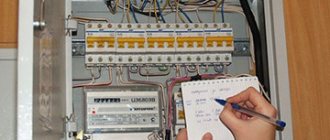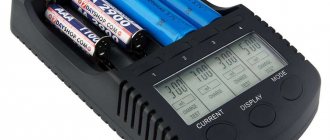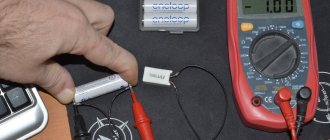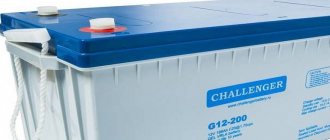The capacity of the battery determines the time during which it is capable of delivering energy to the payload. The unit of measurement for energy capacity is Ampere-hours. Physically, capacity is the product of the battery discharge current (A) and the discharge time (hours). Batteries age over time and their energy reserves decrease. The power supplies themselves are used in mobile devices, cars, etc. Many users need to calculate the battery capacity. There are several ways to do this, and at home.
Battery capacity is a parameter that shows the time during which the battery is capable of delivering energy to the payload.
Battery life calculation
So how do you calculate battery life? Battery capacity is often indicated in ampere-hours, or mAh. It seems nothing complicated, because you have everything, let’s say, a battery with a capacity (C) of 800 mAh for hours and a device with a current consumption (I) of 100 mAh, which means, according to the formula, it can ensure the operation of this device for 8 hours. So? Not really. The amount of electrical energy that can be extracted from the battery depends on the battery discharge current. That is, with a fairly large discharge current, the battery runs out at lightning speed and releases little energy.
This phenomenon was noticed many years ago, but the first person to try to take it into account quantitatively was Peukert, who modified the formula. According to Peukert, the battery discharge time is equal to, where n is the Peukert exponent. Сp – Peukert capacity. I – discharge current. The value of the Peukert exponent can be determined experimentally. It depends on the type of unit and even on its release. Basically, this value lies in the range from 1.1 to 1.3.
For some batteries, the manufacturer indicates it, but this does not happen often. Basically, you can notice the battery capacity data for different discharge times. This is basically enough to find out the value of the Peukert exponent yourself. So you’ve learned how to calculate how long your battery will last.
How long will the battery last to operate the inverter?
So how do you calculate how long your battery will last? Theoretically, in each specific situation, the operating time of the inverter should be calculated separately, based on the following factors:
- Battery capacities.
- Condition of the unit, level of wear and charge.
- Operating conditions.
- The power of the connected devices and the current they absorb.
- Type of load and volume.
But even if everything is taken into account, it is difficult to accurately calculate the operating time of the inverter. Calculating the battery for an inverter without starting the engine using formulas is often quite inaccurate. First of all, because there is no linear dependence in the drop in battery voltage to the minimum permissible values.
This is all because during the operation of the inverter, the battery is affected by many important factors. But, one way or another, calculation using the formula is quite possible. For example and clarity of calculations of the inverter operating time, we use the following data:
- Battery capacity is 60 ampere-hours.
- Powered device, Lenovo G550 laptop.
Input type voltage, which has 19 watts, absorbed current - 3.42 A, power - 19x3.42 = 64.98 watts (rounded to 65). An inverter for a car most often has an efficiency of about 85%, it turns out that if a load of 100 V is connected to it, then it will absorb 115 V from the battery. We calculate the operating time using the formula T (hour) = Ah (amp-hour) x V ( volts) x N (0.85) x K (coefficient 0.5 or 0.25) / P (V), in which:
- T is the operating time of the connected device in hours. Ah is the vehicle battery capacity per ampere hour. V - min. voltage in volts.
- N - efficiency of the inverter device, take the value of 85%, in the formula - 0.85.
- K - max. percentage of the permissible degree of battery discharge depending on the air temperature: 0.5 or 0.25.
- P is the power of the device connected to the inverter in watts.
The result is: for warm weather conditions: T = 60x11.6x0.85x0.5/65 = 4.5 or four hours and thirty minutes, for sub-zero temperatures: T = 60x12x0.85x0.25/65 = 2.3 or two hours and eighteen minutes.
If you have trouble calculating battery life and don't understand the formulas, use a helper. The calculator will immediately solve all your problems, the main thing is to enter the data correctly.
Very important amendment
The above formula is approximately correct for long operating times of the UPS from the battery (more than 8-10 hours). At short discharge times (high discharge currents), the battery releases only part of its capacity. This exact value can be found out from the technical characteristics of the battery, and is approximately reflected in the graph.
Therefore, if according to the above formula the time is about 6 hours, it needs to be reduced by 20%. For 4 hours - reduce by 30%, for 2 hours - by 40%, and if the calculation turns out to be about 30 minutes, it needs to be divided by 2.
To accurately calculate the operating time of a UPS from a battery, you need to use the exact efficiency values of the UPS inverter at a given power and the discharge curves of a given type of battery.
Source
User Experience
Battery problems worried me two years ago, when I didn’t have a license. At first I couldn’t determine its capacity, but then I figured it out. The school offered to do a project on a free topic. I decided to study the correspondence of the parameters indicated on batteries from different manufacturers with their actual characteristics. I did this as a hobby, I did everything for the sake of interest. I didn’t think it would be useful later when I started driving.
Of course, I no longer completely discharge batteries; I use more advanced methods. I always plug in a solid-state relay so that there is no need to completely discharge the drive.
Alexander Kazakov
This is a simple procedure, because the formula for battery capacity is studied in the eighth grade. Of course, not everyone loves physics during their school years and believes that it will not be useful to them in life. But most guys, and girls too, then get behind the wheel
When driving and caring for a car, it is important to understand the basics of mechanics and electricity, so physics should not be neglected. But some people simply forget the acquired knowledge or cannot apply it in practice
However, even those who did not study at school sometimes know the formula for current strength: I = U/R. When this parameter is known, it is enough to multiply it by the operating time.
Victor Shkurapetov
I always take measurements using a full discharge. I believe that this is the only method that gives reliable results, so I only recommend it. Of course, sometimes it’s inconvenient to charge a device for several hours, especially with a large capacity, like in cars. However, I still don’t see an alternative. Moreover, a machine is a mechanism whose serviceability must be carefully monitored. No one would want to be left without lamp light at night or in the fog, because this person would have to wait either for the morning or for the help of fellow motorists. Both options are not a very pleasant pastime.
Andrey Kolegov
Simplified calculation of heat loss compensation
Any calculations are based on certain principles. The calculations of the required thermal power of batteries are based on the understanding that well-functioning heating devices must fully compensate for the heat losses that occur during their operation due to the characteristics of the heated premises.
For living rooms located in a well-insulated house, located, in turn, in a temperate climate zone, in some cases a simplified calculation of compensation for heat leakage is suitable.
For such premises, calculations are based on a standard power of 41 W required to heat 1 cubic meter. living space.
In order for the thermal energy emitted by heating devices to be directed specifically at heating the premises, it is necessary to insulate walls, attics, windows and floors
The formula for determining the thermal power of radiators necessary to maintain optimal living conditions in a room is as follows:
Q = 41 x V,
where V is the volume of the heated room in cubic meters.
The resulting four-digit result can be expressed in kilowatts, reducing it at the rate of 1 kW = 1000 W.
How many ampere hours does a car battery have?
Battery capacity is a variable value, depending on the individual characteristics of the battery. Usually the battery is assembled in series, which means the capacity is measured according to the weakest bank. The voltage is summed up.
It is known that liquid acid batteries have 6 cans, each of them carries a voltage of 2.1 - 2.15 V. Capacity is the amount of energy in ampere-hours stored in the battery. This indicator is a passport characteristic.
You can find the actual capacity by measuring the energy output from a full charge to the minimum possible discharge at a constant current and resistance. Time and current strength are recorded. Their product determines the battery capacity in ampere hours. The indicator will differ from the passport value, since the battery capacity is constantly decreasing due to additional chemical reactions.
Self-discharge control
Every battery inevitably loses its charge. To control the ampere-hour consumption of a battery, calculations are required. First you need to calculate the energy that is stored in the drive at the time of full charge. This will have to be done immediately after disconnecting the battery from the network. We recommend: Titan Arctic: high-quality titan car batteries Then you need to leave it for about a month, and then repeat the steps. If deadlines are pressing, then you can wait just a week and multiply the result by four. Normal consumption values for an average device are considered to be a tenth of the full capacity per week or four such parts per month.
Monoblock
You can assemble a battery from individual batteries using a copper wire or a bus bar with terminals. This process, although simple, is still quite labor-intensive, so ready-made monoblocks are made in factories. They consist of several elements assembled in one case made of durable plastic. Monoblock lead-acid batteries typically consist of 6 or 12 individual cells. The voltage is 12 V or 24 V, respectively.
Monoblock
All elements of the monoblock are no different from each other, and they age simultaneously, so the service life of the monoblock is longer than that of each individual battery. In the process of assembling a monoblock, it is possible to use both parallel and serial connections of its individual elements.
Note! Battery life is measured not in years or months, but in the number of charging cycles. To ensure that the battery lasts as long as possible, it is advisable to recharge it after using only a small part of its rated capacity.
Specific thermal power of battery sections
Even before performing a general calculation of the required heat transfer of heating devices, it is necessary to decide what material the collapsible batteries will be installed in the premises from.
The choice should be based on the characteristics of the heating system (internal pressure, coolant temperature). At the same time, do not forget about the greatly varying costs of purchased products.
How to correctly calculate the required number of different batteries for heating will be discussed further.
At a coolant temperature of 70 °C, standard 500 mm sections of radiators made of dissimilar materials have unequal specific thermal power “q”.
- Cast iron - q = 160 Watt (power density of one cast iron section). Radiators made of this metal are suitable for any heating system.
- Steel - q = 85 Watt . Steel tubular radiators can operate in the harshest operating conditions. Their sections are beautiful in their metallic shine, but have the lowest heat transfer.
- Aluminum - q = 200 Watt . Lightweight, aesthetic aluminum radiators should be installed only in autonomous heating systems in which the pressure is less than 7 atmospheres. But their sections have no equal in terms of heat transfer.
- Bimetal - q = 180 Watt . The insides of bimetallic radiators are made of steel, and the heat-dissipating surface is made of aluminum. These batteries will withstand all pressure and temperature conditions. The specific thermal power of bimetal sections is also high.
The given values of q are rather arbitrary and are used for preliminary calculations. More accurate figures are contained in the passports of the purchased heating devices.
Image gallery
Photo from
Advantages of the sectional assembly principle
Basic rules for assembling heating devices
Sections of an obsolete cast iron battery
Powder coated colored sections
How to check the battery when purchasing?
Having selected the desired battery, do not forget to check its performance. This can be done simply by connecting a load plug to it. With its help, you measure the voltage at idle and under load. Every self-respecting store should have a loading fork! Don't have such a device? Consider purchasing your battery elsewhere.
All batteries are divided into three categories:
1. Serviceable or repairable batteries - devices that were in demand a few years ago are not so popular today. The battery case is made of ebonite, filled with mastic on top.
2. The batteries are maintenance-free. This type of battery is designed to work under ideal conditions.
3. For our realities, the most suitable type of batteries is low-maintenance. They are distinguished by a favorable price, good quality and a long service life.
When choosing a battery, you need to find out its release date. As noted earlier, the battery life is 3-5 years; naturally, the newer the device, the longer it will last. By the way, this period begins to be calculated not from the day it is installed in the car, but from the moment the electrolyte is filled.
The cost of a battery is directly proportional to its starting current capacity. The larger the battery capacity, the faster the starter will crank the car engine.
It is better to buy batteries in specialized stores. Professional consultants will competently select the battery for your car. In such stores you will buy a genuine certified product, and if a defect is detected, your device will be replaced. But, when purchasing, be sure to check that the warranty card and the issued receipt are filled out correctly.
Is it possible to increase the capacity
The battery capacity can be increased only slightly. In general, this process has two sides to the “coin”:
- On the one hand, this is necessary if additional electrical equipment is connected to the on-board network. In addition, in the cold season, the capacity reserve is very useful, because when the air temperature decreases by one degree, the power correspondingly decreases by 1 Ah.
- On the other hand, when not operating in standard mode, the starter is subject to greater wear. And also the generator characteristics may not be sufficient to fully charge the battery.
What affects the battery capacity under real operating conditions?
The actual capacity of a car battery, as a rule, differs from the nominal one. The longer the battery life, the more significant its reduction. There are several reasons that provoke this process:
- terms of Use;
- features of meeting deadlines and service technology;
- battery charging method.
Practical example of calculating thermal power
Initial data:
- A corner room without a balcony on the second floor of a two-story cinder block plastered house in a windless region of Western Siberia.
- Room length 5.30 m X width 4.30 m = area 22.79 sq.m.
- Window width 1.30 m X height 1.70 m = area 2.21 sq.m.
- Room height = 2.95 m.
Calculation sequence:
| Room area in sq.m.: | S = 22.79 |
| Window orientation – south: | R = 1.0 |
| Number of external walls – two: | K = 1.2 |
| Insulation of external walls is standard: | U=1.0 |
| Minimum temperature – up to -35°C: | T=1.3 |
| Room height – up to 3 m: | H=1.05 |
| The upstairs room is an uninsulated attic: | W=1.0 |
| Frames – single-chamber double-glazed windows: | G=1.0 |
| The ratio of window and room areas is up to 0.1: | X = 0.8 |
| Radiator position – under the window sill: | Y=1.0 |
| Radiator connection – diagonally: | Z=1.0 |
| Total (remember to multiply by 100): | Q = 2,986 Watts |
Below is a description of calculating the number of radiator sections and the required number of batteries. It is based on the obtained results of thermal power, taking into account the dimensions of the proposed installation locations of heating devices.
Regardless of the results, it is recommended to equip not only window sill niches with radiators in corner rooms. Batteries should be installed near “blind” external walls or near corners that are subject to the greatest freezing under the influence of street cold.
Recommendations for selection
Most often, vehicle owners, when choosing, focus on the size of the power plant. You can use a special table for this:
It is immediately noticeable that batteries with a capacity of 50 to 65 Ah are most often used for installation in passenger cars. If the battery is selected for an SUV, then this parameter should be in the range of 70–90 Ah. You should also remember two nuances, because of which it is worth taking a battery with a slightly larger capacity:
- There are a large number of energy consumers in the on-board network.
- The car has a diesel power plant.
In winter, this reserve will help start the engine without unnecessary problems. However, you should not use a battery with a very high capacity. This is due to the fact that the on-board network is designed to work with batteries that have certain electrical characteristics. As a result, the generator will not be able to fully charge such a battery. In addition, the starter will also work under strain, which can lead to its premature failure.
Battery Maintenance Rules
How to check the capacity of a 18650 battery with a multimeter
The main purpose of a battery in a vehicle is to start the car engine. In addition, the battery becomes an emergency power source if the generator fails. There are requirements for the operation and maintenance of batteries that every car owner should know.
It is recommended not to remove the battery from vehicles with the engine running. This in some cases can damage the integrity of the generator. Before removing the battery, you need to turn on a 12 V incandescent lamp in parallel with it. In this case, the circuit will not open and the generator will not work on itself. Most of the batteries that are currently produced are lead-acid, and they use the double sulfation option.
This technology has existed since 1858 and is still used in its original form today. True, recently, batteries for cars with immobilized electrolyte have been produced to a greater extent. They are able to work in all spatial positions. The battery consists of a container in which there are six separate sections. Each section produces independent energy, and since there are plates, the process of electrolysis occurs. The mass of the battery is 16-17 kilograms, it includes: electrolyte, lead plates, as well as additional connections.
How does the battery work? The principle of its operation is very simple. There is dark brown lead oxide on the anode. On the cathode there is spongy gray lead, inside there is a solution of sulfuric acid (electrolyte). During the chemical reaction, zinc sulfate is formed and energy is released. In order to maintain the battery, no special actions need to be taken.
There are four main battery options, namely:
- serviced;
- unattended;
- hybrid;
- low maintenance.
Let's talk about all the varieties in a little more detail, since they are all used to some extent in everyday life and in technology.
- Serviced batteries are produced in small quantities and are more often found in highly specialized industries. They are expensive and not resistant to temperature changes. That is, at low temperatures they can spontaneously discharge.
- Low-maintenance batteries are widespread, their prices vary widely, they are reliable and durable.
- Maintenance-free batteries are suitable for those who do not want to spend effort on caring for the battery.
- Hybrid batteries are more expensive and are rare. It is better to leave charging batteries to professionals.
In order for the battery charging process to be safe, it is advisable to carry out such activities outside the living area. The fact is that when charging, hydrogen vapor is released, which can ignite. Therefore, charging the battery near open sources of fire is strictly prohibited.
Internal resistance
Internal resistance is also a fairly important parameter of the battery. The unit of internal resistance is milliohm (mOhm). Resistance, in turn, depends on the capacity of one battery cell (cell), the number of these cells, the type of battery, service life and operating conditions. The internal resistance is determined using analyzer devices.
As the battery operates, the internal resistance gradually increases. If the battery has a resistance of as much as 500 ohms, then we can conclude that it is very old or has simply been used incorrectly.
High internal resistance leads to increased energy consumption and, as a consequence, to shorter operating time of devices, since, according to Ohm's law, high resistance significantly increases current consumption and a simultaneous voltage drop. And if there is a strong voltage drop, the connected electrical appliance mistakes the battery for a discharged one or simply for one that is not able to work. As a result, the battery cannot release all the stored energy, which significantly reduces the operating time of electrical appliances.
Battery self-discharge is the spontaneous loss of electricity from a charged battery over a period of time. Almost all types of batteries are susceptible to this phenomenon, regardless of their design and electrochemical type.
To quantify self-discharge, the amount of energy that a battery loses over a certain period of time is used, and it is calculated as a percentage of the size of a fully charged battery. The amount of self-discharge is not constant; for example, in the first day after charging it reaches maximum values, and then gradually decreases.
In this regard, it is customary to measure the amount of self-discharge on the first day, and then a month after charging. Self-discharge is also influenced by ambient temperature, and the relationship between the magnitude of self-discharge and temperature is proportional. This means that as the temperature increases, the amount of self-discharge also increases.
For example, for some types of batteries, when the temperature rises from 20 to 30 degrees, the self-discharge value doubles. If we talk about its more specific values, then for Ni-Cd type batteries the normal value is 10% per day, and Ni-MH type batteries have a slightly larger self-discharge value, for Li-Ion and for Li-Pol this value is so small that it is assessed only a month after the charge. As for the monthly self-discharge value, for the same types of batteries we have the following parameters:
- Ni-Cd - 20%
- Ni-MH - 30%
- Li-Ion - 10%
These figures are statistical averages and may differ slightly for each specific battery.
To determine the service life of a battery, use the number of cycles between charge and discharge of the battery, which it is able to withstand during operation, without significantly changing its main parameters, such as capacity, self-discharge value, and internal resistance.
The time that has elapsed since the battery was manufactured is also taken into account. If the capacity decreases to 60% of the nominal value, the battery is considered failed. The service life is influenced by a variety of factors:
- battery type
- charging method
- terms of Use
- correct service
Depending on the electrochemical system used, all batteries are divided into the following types:
- SLA/Pb - classic lead-acid
- Ni-Cd - nickel-cadmium
- Ni-MH - nickel metal hydride
- Li-Ion - lithium-ion
- Li-Pol - lithium polymer, which is a relatively new word in modern technology.
Verification methods
Each battery has a certain service life. This indicator largely depends on its capacity, which tends to decrease as the device is used. The fact is that the battery does not store energy, but contains chemically active substances, the interaction of which allows the generation of electric current. Over time, the degree of reaction deteriorates, which means that the battery capacity has a great influence on the performance of the car.
Reducing this parameter leads to startup problems. To avoid this, it is advisable to keep it under control. To do this, you need to learn to determine its value at any time. There are many ways to determine battery capacity. Let's look at the simplest ones:
- Load testing. A light bulb is usually used as the latter. If the nominal capacity is not large, then a headlight is quite suitable. Algorithm of actions:
- disconnect the battery from the generator;
- connect the load for a period of time from one to two minutes;
- remove the load; connect a multimeter to the battery in capacity determination mode;
- fix the value.
- Using the tester. This is a device with advanced functionality. We select the required operating mode using a special button. We take measurements and determine the value.
You can read more about capacity testing methods here.
How to find out the battery capacity?
When choosing a phone, some users really pay attention to such an indicator as capacity. With it, they are confident that they will be able to choose a more durable device that will delight them without recharging for a longer period of time.
You can find out the capacity in the technical characteristics of the device (they can be seen both in a regular store on display with the phone and in online stores) upon purchase, and simply look at it by removing the back cover of the phone yourself. Under it you will see the battery label - the manufacturer, certificate and, of course, its capacity will be indicated there (in mAh or mAh - this is the same thing).
How is capacity calculated?
When calculating the battery capacity, you need to remember that the battery cannot be completely discharged - you should leave at least 30% of its charge. The value of this parameter must satisfy the needs of the vehicle’s autonomous power supply system.
Let's look at an example of how to correctly calculate the battery capacity. Let’s say the total power of the car’s electrical appliances is 500 Wh. The voltage value of all batteries is the same and is 12 V. The amount of energy that a battery is capable of producing is equal to the product of its capacity and voltage, that is:
Q = E × U, where
Q – amount of energy stored by the battery; E – battery capacity; U – battery voltage = 12 V.
Since the battery energy can only be used by 70%, therefore, the formula for the amount of energy supplied by the battery will be as follows: Q = E × U × 0.7.
How to calculate the battery capacity in this case? From the expression it is easy to determine E = Q / (U × 0.7).
At Q = 500 Wh
E = 500 / (12 × 0.7) = 59.52 Ah.
Thus, we find that a battery with a capacity of 60 Ah is required. What does this battery capacity mean for a car? The fact that the discharge current value is 60 Amperes.
Calculation of battery capacity
Measuring the battery volume is necessary when determining the amount of energy for long-term battery life of any device (for example, a laptop, smartphone, etc.);
In order to determine the battery capacity, you need to apply the standard formula:
Q=(P*t)/V*k,
where Q is the calculated battery capacity (A*h or mA*h);
P – load power (W);
t — reservation time period (h);
V—battery voltage (V);
k is a coefficient showing how much of the battery capacity is used.
The k value compensates for the situation when the battery is not fully charged. By the way, a full discharge after several full cycles of operation significantly increases the performance of the device.
How to connect batteries to increase the total capacity?
To achieve the goal of increasing the technical characteristics of the power source during operation of the device or device, there are options for different connections of the elements of the electrical circuit.
There are two connection methods or schemes:
- Serial connection.
- Parallel connection.
The battery capacity for serial and parallel connections will be different. The first method will increase only the total voltage, and the second will increase the total C b as many times as there are elements in the circuit:
C∑ = C1 + C2
Before starting the experiment, you need to take two battery power supplies with the same degree of wear and charging, and two diodes. For a parallel connection, the minuses of the batteries need to be connected together, and the plus of one to the anode of one diode, plus the other to the anode of the other. The cathodes of the diodes also need to be connected to each other. Turn on the load with a minus at the connection point of the negative terminals of the elements, with a plus at the junction of the diode cathodes. This connection scheme will double C b. It is impossible to assemble such a circuit without diodes, since the batteries will discharge one through the other.
Increased heat transfer efficiency
When the radiator heats the internal air of the room, intense heating of the external wall in the area behind the radiator also occurs. This leads to additional unjustified heat losses.
To increase the efficiency of heat transfer from the radiator, it is proposed to fence off the heating device from the outer wall with a heat-reflecting screen.
The market offers many modern insulating materials with a heat-reflecting foil surface. The foil protects the warm air heated by the battery from contact with the cold wall and directs it inside the room.
For proper operation, the boundaries of the installed reflector must exceed the dimensions of the radiator and protrude 2-3 cm on each side. The gap between the heating device and the thermal protection surface should be left 3-5 cm.
To make a heat-reflecting screen, we can recommend isospan, penofol, alufom. A rectangle of the required dimensions is cut out of the purchased roll and fixed on the wall at the location where the radiator is installed.
It is best to fix the screen that reflects the heat of the heating device on the wall with silicone glue or liquid nails
It is recommended to separate the insulation sheet from the external wall with a small air gap, for example, using a thin plastic grid.
If the reflector is joined from several parts of insulating material, the joints on the foil side must be sealed with metallized adhesive tape.
On which devices can you find out the battery capacity using the methods presented?
You can get information about battery capacity using the options discussed on various devices. The methods help to calculate the battery capacity of a tablet, phone, laptop, car, electric bicycle, UPS and other devices.
An example of calculating battery capacity is presented in the video.
The battery capacity can be calculated at any time of use. The use of one of the methods should depend on the type of device and its power source. The choice is influenced by the required voltage, charging and discharging time. A detailed study of the methodology will allow you to determine values quickly and accurately, avoiding errors and deviations.
Calculation of the number of radiator sections
Collapsible radiators made of any material are good because to achieve their calculated thermal power, you can add or subtract individual sections.
To determine the required number “N” of battery sections from the selected material, the formula is followed:
N=Q/q,
Where:
- Q = previously calculated required thermal output of devices for heating the room,
- q = specific thermal power of a separate section of batteries proposed for installation.
Having calculated the total required number of radiator sections in the room, you need to understand how many batteries need to be installed. This calculation is based on a comparison of the dimensions of the proposed installation locations of heating devices and the dimensions of the batteries, taking into account the connections.
The battery elements are connected by nipples with multi-directional external threads using a radiator wrench, and at the same time gaskets are installed at the joints
For preliminary calculations, you can arm yourself with data on the width of sections of different radiators:
- cast iron = 93 mm,
- aluminum = 80 mm,
- bimetallic = 82 mm.
When making collapsible radiators from steel pipes, manufacturers do not adhere to certain standards. If you want to install such batteries, you should approach the issue individually.
You can also use our free online calculator to calculate the number of sections:
Main battery characteristics
Before buying a battery, you need to understand what parameters it must meet. The battery must be compatible with all equipment and the vehicle's electrical system.
Options:
- nominal and reserve electrical capacity;
- starting current;
- power;
- dimensions;
- weight.
Electric capacity is the amount of electricity that can be obtained from a battery when it is discharged for a long time.
There are two types of containers:
- Nominal. To determine this, the battery is discharged at 25°C for 20 hours. For this purpose, a current of 5% of the rated capacity declared by the manufacturer is used.
- The reserve capacity is determined by discharging the battery with a current of 25 A at a temperature of 26 °C. This characteristic shows how long in minutes a car can travel with the generator turned off.
In order to figure out how to determine the power of a battery, you will have to remember physics and electrical engineering. Power is the discharge current multiplied by the average voltage in the electrical circuit (P=I*Y).
The formula shows that with an increase in the power required to start the engine, the average voltage in the car network will drop, and the starter will begin to work more slowly. The starting current of a battery is always directly proportional to its power.
In addition to the starting current, power and battery capacity, it would be useful to pay attention to other necessary parameters:
- polarity of terminals;
- compliance of dimensions;
- fastening.
The condition of the battery and its service life largely depend on the health of the vehicle and operating conditions.
Car battery capacity
As already mentioned, battery capacity is measured in ampere-hours. This value is usually contained on the car battery sticker along with the starting current value. An example can be seen below.
Battery capacity designation
One of the first to derive the formula for this dependence was Peukert, a German scientist. He derived the following formula:
Cp = Ik * t, where
Cp - battery capacity,
k is the Peukert coefficient,
t – time.
The Peukert coefficient used in the formula is a constant value for a certain type of battery. For automobile lead-acid batteries, the Peukert number lies in the range of 1.15─1.35. This constant is determined by the nominal capacity of the battery.
As a result, a formula was derived for calculating the actual battery capacity at an arbitrary value of the discharge current:
E =En( In/I){p-1}, where
En is the nominal capacity of the battery,
E – actual battery capacity,
In is the rated value of the discharge current at which the rated capacity is set. Current in a cycle of 10 or 20 hours. Typically this is 9 percent of En.
Everything that was said above concerned the nominal capacity of a car battery. There is also the concept of reserve capacity. If the nominal value was determined as a result of discharge with a small current, then the reserve value shows how much the car battery will last if the generator fails. The discharge current is set to 25 amperes. Heating and lighting are taken into account here. In the event of a discharge with such a current, the reserve capacity is about two-thirds of the nominal value. If it is applied to the label of a car battery, then it is indicated in minutes.
The nominal capacity of the battery is determined by a number of technological and design characteristics. The operating conditions of the car battery also have a very strong influence. Among the primary characteristics that influence this parameter are the composition of the electrolyte, the amount of active mass, the geometry and thickness of the lead plates. The main technological characteristics that determine the size of the container are the composition and porosity of the active mass. In addition, the discharge capacity, as mentioned above, is affected by the magnitude of the discharge current and the temperature of the electrolyte.
Conversion to watt hours
Often, battery manufacturers indicate in the technical specifications only the stored charge in mAh (mAh), others - only the stored energy in Wh (Wh). Both characteristics can be called the term “capacitance” (not to be confused with electrical capacitance as a measure of a conductor’s ability to accumulate charge, measured in farads). Calculating the stored energy from the stored charge is not easy in the general case: it requires integration of the instantaneous power supplied by the battery over the entire time of its discharge. If greater accuracy is not needed, then instead of integration, you can use the average values of voltage and current consumption, using the formula following from the fact that 1 W = 1 V 1 A:
1 W h = 1 V 1 Ah.
That is, the stored energy (in watt-hours) is approximately equal to the product of the stored charge (in ampere-hours) and the average voltage (in volts
)
: E
=
q
U.
joules
it will be 3600 times greater,
E
=
q
U 3600,
Example
The technical specification of the device states that the “capacity” ( stored charge
) of the battery is 56 A·h, the operating voltage is 15 V. Then the “capacity” (
stored energy
) is equal to 56 A·h · 15 V = 840 W·h = 840 W · 3600 s = 3.024 MJ.
When identical batteries are connected in series, the “capacity” in mAh remains the same, but the total voltage of the battery changes; when connected in parallel, the “capacity” in mAh is added up, but the total voltage does not change. In this case, the “capacity” in W h for such batteries should be considered the same. For example, for two batteries, each of which has a voltage of 3.3 V and a stored charge of 1000 mAh, a series connection will create a power source with a voltage of 6.6 V and a stored charge of 1000 mAh, a parallel connection will create a source with a voltage of 3. 3 V and a stored charge of 2000 mAh. The capacity per W hour (the ability to do work) in both cases, without taking into account some nuances, will be the same. In modern Power Banks, which have become widespread recently, the batteries inside are often connected in series, and the total “capacity” in mAh is added up. This is due to the fact that such Power Banks have an internal controller that converts the voltage and offers several voltage values at the output: 5 volts (USB port), 12, 15, 17 or 19 volts for connecting laptops. That is, there is no way to indicate at what voltage this or that “capacity” in mAh is appropriate, since it changes depending on the voltage used by the consumer connected to such a universal Power Bank. Therefore, in the characteristics they write the “commercial” capacity in mAh, obtained as the sum of series-connected battery cells, without indicating, at the same time, the voltage at which this “capacity” in mAh. appropriate. It should also be taken into account that the battery capacity and its voltage are interrelated quantities, since a battery that is discharged loses voltage. Moreover, measuring the voltage of a discharged battery or battery without a load may not reveal the degree of discharge of the power source, since at “idle”, without load, the battery can show a high voltage, which will drop sharply if the battery or battery is discharged and if a specific load is connected to them, unlike charged power supplies, which maintain a high voltage value even after connecting the load. For discharged batteries, the voltage drop when a load is connected is greater than for charged power sources. To test car batteries, special “probes” are often used, which create a standard load on the battery.
Indicators of batteries, with which the concept of capacity is inextricably linked
1. Dependence of battery capacity on its discharge current.
This dependence is based on the following fact: when the protected load is connected to the battery without using a converter, the amount of current consumed by the battery remains unchanged. In this case, the operating time of connected electrical consumers will be determined as the ratio of the selected capacity to the consumed current. In a more familiar form, this formula is written as follows:
Q = I T
where Q is the battery capacity, Ah (mAh);
I – constant battery discharge current, A;
T – battery discharge time, hours.
If we are dealing with large amounts of current consumption, then the actual power indicators are often lower than the nominal ones indicated in the passport.
2. Dependence of battery capacity on energy
Today, it is quite common among users that the capacity of a battery is a value that fully characterizes its electrical energy, accumulated by the battery when it is 100% charged. This statement is not entirely correct. Here it is also necessary to make a reservation that the battery’s ability to store energy directly depends on its voltage and the higher it is, the more energy the battery can accumulate. In fact, electrical energy is defined as the product of the charging current, battery voltage and the flow time of this current:
W=I·U·T
where W is the energy accumulated by the battery, J;
U – battery voltage, V;
I – constant battery discharge current, A;
T – battery discharge time, hours.
Based on the fact that the product of current and charging time gives us the battery capacity (as discussed above), it turns out that the electrical energy of the battery is found by multiplying the rated voltage of the battery and its capacity:
W=QU
where W is the energy accumulated by the battery, Wh;
Q – battery capacity, Ah;
U – battery voltage, V.
When several batteries of the same capacity are connected in series, the total indicator of this bundle is equal to the sum of the capacities of all batteries included in its composition. In this case, the energy of the resulting battery pack will be determined as the product of the electricity of one battery and their number.
3. The concept of battery energy capacity
An equally useful indicator for the consumer of rechargeable batteries is their energy capacity, measured in units such as W/cell. This concept characterizes the battery’s ability for a certain short period of time, which most often is no more than 15 minutes, in constant power mode. This indicator is most widespread in the United States, but has recently been gaining popularity among consumers in many other countries. To approximate the calculation of the battery capacity, measured in Ah based on its energy capacity in W/cell for a period of 15 minutes, use the formula:
Q = W/4
where Q is the battery capacity, Ah;
W – energy capacity of the battery, W/cell.
4. The concept of battery reserve capacity
For car batteries, another characteristic is distinguished - reserve capacity, which indicates the battery’s ability to power the electrical equipment of a moving car when the vehicle’s standard generator is not working. This parameter is also better known in the USA and is called “reserve capacity”. It is measured in minutes of battery discharge with a current value of 25 A. To approximate the nominal capacity of the battery based on its reserve capacity indicator, indicated in minutes, you must use the formula:
Q = T/2
where Q is the battery capacity, Ah;
T – battery reserve capacity, min.
conclusions
- The electrical capacity of a battery is the most important indicator of the amount of electrical energy and the duration of its operation, expressed in numerical values. It can be determined, calculated, increased using various methods.
- Battery capacity (volume) may be different for both primary and secondary sources, but the latter can be recharged using chargers (chargers).
- Battery capacity depends on the type of cell, chemical reaction, external conditions, load current, shelf life and method of operation. If you violate the rules of use, you can quickly damage the battery, and with the right approach, its use time can be significantly extended.
- Batteries or accumulators manufactured by well-known manufacturers, as a rule, have proven themselves well in the consumer market, in that they guarantee the declared technical characteristics and high-quality, uninterrupted service in devices for a long time.
What is capacity and why is this indicator needed?
The capacity of the battery is its key characteristic.
It affects the cost of the device, scope of application (from household needs to medical), and service life. This characteristic displays the duration of the time period during which the battery will fully power the corresponding device (remote control, telephone, etc.) and ensure its autonomous operation. In other words, battery capacity is the maximum amount of electrical energy that the battery can accumulate in 1 full charge cycle.
The unit of measurement for battery capacity is amperes per hour (Ah), and for high-power batteries - milliamps per hour (mAh).











